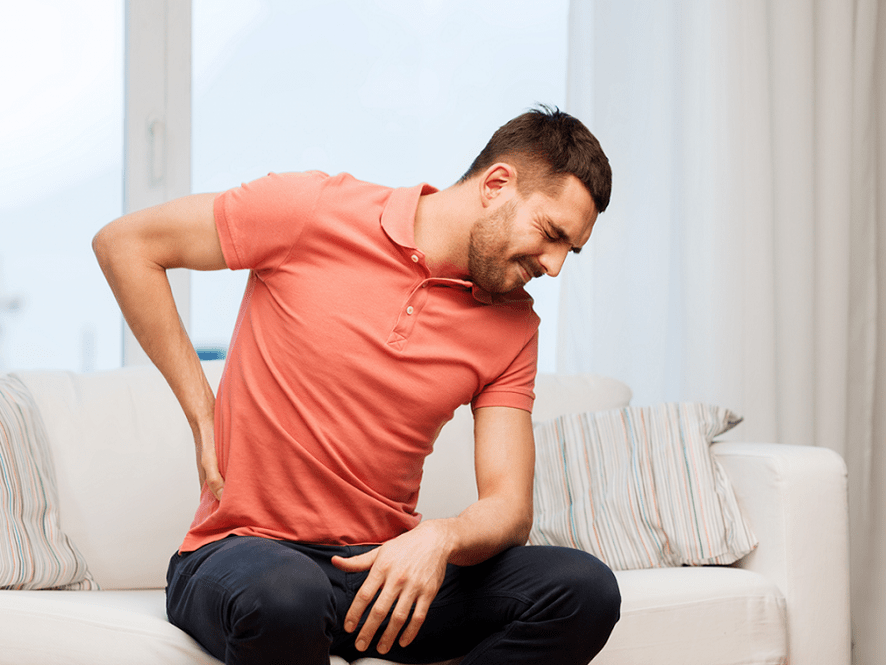
Lower back pain can be associated with a variety of reasons - for example, muscle damage, bowel pathology, bulging, and vertebral hernia. It is impossible to determine the exact cause on your own. Therefore, if discomfort occurs, it is necessary to undergo a diagnosis and follow the doctor’s recommendations. In most cases, medications and procedures are used for treatment. But surgery may be needed.
Lower back pain: reasons
Lower back pain can be related to the spine, muscles, nervous and other systems. The most common reasons are:
- Traumatic injuries of the lumbar or other parts of the spine.
- Muscle tissue damage or severe tension.
- Hernia, bulge.
- Curvature.
- Neuropathy
- Inflammatory processes of vertebral tissue.
- Tight nerve.
- Pathologies of the intestine, stomach, liver and other digestive organs (in this case the pain is also given to the lumbar region).
- Poisoning, intoxication.
- Excretion pathologies - renal failure, pyelonephritis, cystitis, kidney stones, ureters.
- Uterine diseases - cysts, fibroids, inflammatory processes.
What to do if your lower back hurts
It is impossible to reliably determine the source of pain at home. Therefore, in case of foreign sensations, consultation with a doctor is recommended. If diagnosed in time, treatment will be successful and quick. You must contact such experts:
- Surgeon or traumatologist - if the pain is related to the latest herbs, including sports or home herbs.
- Neurologist - painful sensations of acute, shooting character. They may be accompanied by problems with leg sensitivity, loss of mobility. Symptoms such as geese on the surface of the abdomen or on the legs are also noticed.
- Gastroenterologist - pain that pulls for a long time mainly on one side of the lumbar region. Also, feelings can be painful, accompanied by too frequent or difficult urination.
- Gynecologist - in this case the pain is observed from one side and from two sides. Moreover, they are accompanied by weakness, worse during walking and running, during menstruation, as well as during pregnancy.
In rare cases, when the cause of the pain is objectively clear, you should not worry. Thus, if external feelings are associated with a long stay in one position, physical activity, it is not necessary to consult a doctor. But if the pain does not go away in a few days or is of an acute nature, it is necessary to come for an examination and get a diagnosis as soon as possible.
Lower back pain: diagnosis
Diagnosis is prescribed by a doctor after examination, examination of complaints and anamnesis. The need for a special procedure depends on which symptoms accompany the pain:
- X-rays of the spine - hernias, bulges, back injuries, posture problems.
- MRI of the lower back - for hernias, curvatures, injuries, as well as for suspected neoplasms.
- CT of the lower back - the same indications as for MRI.
- Ultrasound - suspected pathology of the intestine and other organs located in the abdominal cavity.
- Colonoscopy, gastroscopy - these studies are performed in case of suspicion of diseases of the gastrointestinal tract. In this case, the doctor not only examines the organs, but can also take a tissue sample (biopsy) for further research.
- Intensive magnetic resonance imaging of the bowel is performed to examine the gastrointestinal tract in more detail to confirm or confirm a previously made diagnosis.
Methods of treatment
Methods, duration, treatment regimen are determined by the doctor depending on the diagnosis. In most cases, drugs are indicated, for example, nonsteroidal anti-inflammatory drugs. It is also possible to attend massages, perform physiotherapy procedures.
If the diagnosis involves only surgical treatment, surgery is performed. This is necessary, for example, in the presence of hernia, peptic ulcer and other pathologies.
Prevention of back pain
Lower back pain may be related to working conditions and lifestyle. The main physical activity falls on the lumbar region. This is especially dangerous with constant weight lifting, bodily injuries or sports injuries.
For prevention it is recommended:
- Exercise regularly.
- If the job involves physical work, learn to lift weights properly and not strain your back.
- If the work is associated with a long stay in a sitting position, get up regularly, walk, change posture.
- Avoid hypothermia of the back, dress according to the weather.
- Keep your back straight while sitting and while holding.
- Eat a balanced diet.
- Do not abuse alcohol, smoking or other bad habits.
If the pain recurs quite often, and is even more acute in nature, you should see a doctor immediately. It is important to understand that treatment often takes several months, especially when you are recovering from surgery. In this case, it is worth adjusting the way of life, if necessary, change jobs.



































